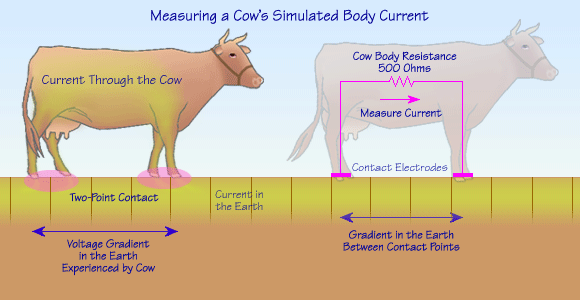Current Flow |
|
|
|
Each of the definitions of stray voltage mentions a current flowing through the cow after contact is established with a gradient source. It is the current—when present at sufficient levels—that the cow will feel, and not the voltage. So, what should we measure and how? Measuring the current directly would be the preferred approach, but we cannot get inside the cow to measure the current, nor do we have sensors for the cow to wear that would tell us about these currents.
|
|
As we have seen,
given a certain difference in electric potential between two points, the current that will flow between the two points depends on the electrical resistance of the material between these two points. In a previous section
[What is Gd?] we learned about the earth's electrical resistance when rods are installed at two points in the earth with a voltage difference applied between them.
The relationship among voltage, resistance, and current is a recurring model.
|


|
|
In this situation, some type of electric voltage is present on the surface of the earth to which the cow may be exposed. We have seen that cows may experience some of the voltage differences in a voltage gradient plane as contact voltage. We are now considering how much current will flow through the cow as a result of this contact voltage. In this case, the two points are the parts of the cow that make contact with the earth, and the medium between them is the cow itself. This time, we are not interested in finding out how the current will distribute itself inside the cow; we are interested simply in appraising how much current will flow through the cow altogether.
|
|
A model may be used to appraise this current, but this has become the source of some debate and controversy. Models can be created according to engineering practices which yield useful results but are complex. A simpler model has been developed for appraising stray voltage problems on locale; it focuses on the worst-case measurement of the current that could flow through the cow.
|


|
|
Many testing procedures, however, do not meet the tenets of exposure
[Exposure Vital] but make arbitrary measurements of stray voltage with no scientific basis. They have, nevertheless, gathered an audience.
Such cases are often based on circumstantial and faulty data with only presumptions about the relationship between the phenomena supposedly represented by these measurements and the well-being of the cow.
|
|
For example, someone places test electrodes in the earth with an instrument between them measuring some electrical activity. It is then suggested that this is evidence of earth current causing a cow lying on the ground nearby to become sick. While this might make for interesting TV news, it is not science. In this example, the basic tenets of stray voltage exposure are being ignored. One major failure in proving exposure is that the interaction of the current with the cow (mechanism) is never explained. If electrical conduction is being assumed, then current measurement should be the focus of the investigation. If electromagnetic fields (EMF) are being imagined instead, then electric and magnetic field exposure assessments must be the focus.
|


|
|
The body current simulation model used by experts in the investigation of stray voltages is based on the results of many studies and scientific reports on the electric resistance of the body of a cow. The United States Department of Agriculture, in Agriculture Handbook Number 696, summarizes the scientific consensus that this pathway resistance through the body of a cow for stray voltage exposure assessment is in the range of 500 to 1000 ohms in the worst case. That is, very few cows in a large herd will show a body resistance this low, while the rest of the cows will show much higher body resistance.
|
|
It has become a practice to simulate the worst-case body resistance of a cow at 500 ohms. Such a resistance connected between the two points normally contacted by a cow allows experts to measure current that a very sensitive cow could experience at that location. The majority of the cows will have a much higher body resistance, which means a much lower body current resulting from the same contact voltage. This makes the model the worst case since no cows will experience a current higher than what is being measured in this model.
|
|
The testing model is illustrated in the figure below. To ensure that this model remains a worst case, the contact electrodes must have as little resistance as possible. To ensure uniformity and repeatability of testing, specific protocols have been developed that specify the size of the electrodes, the force used to press them against the contact points, etc.
|


|
 |


|
|
Current flow through the body of a cow is a principle of stray voltage exposure and is an element of each of the stray voltage definitions that we have examined. It is a key determinant of stray voltage. If current flow cannot be shown, or if it is not significant enough to be perceived in the worst case, then there is no stray voltage problem.
|
|
|





|
